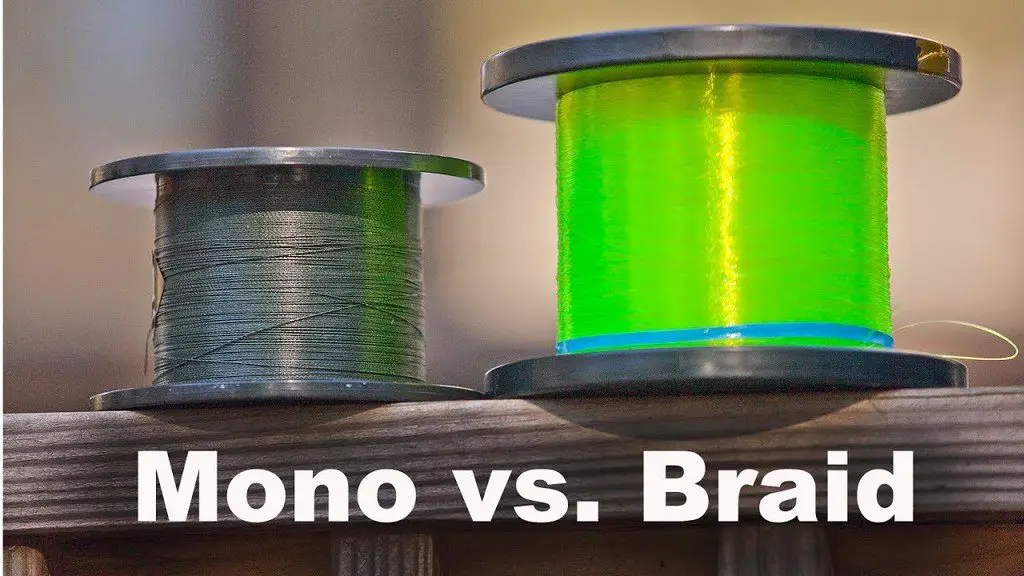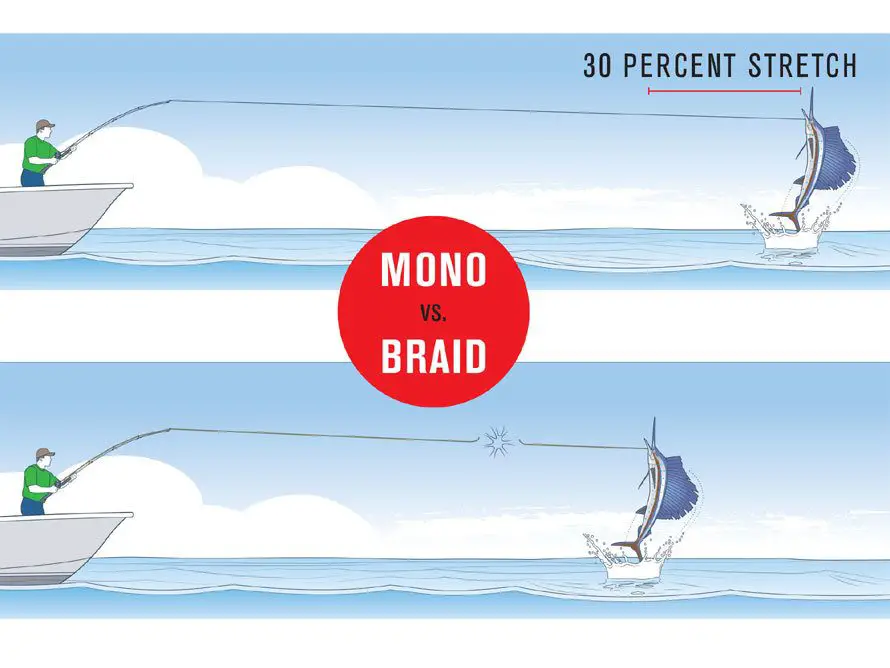Braid fishing line offers greater strength, sensitivity, and casting distance, with minimal stretch and a smaller diameter. Mono line provides more stretch, better abrasion resistance, and lower visibility, making it more forgiving for beginners. Choose based on your fishing technique, target species, and personal preferences.
Most anglers might think that the choice between using braid vs monofilament fishing line comes down to personal preference in most cases. This is not entirely true as each type of line has specific advantages that anglers can use depending on their fishing method.
Braided and mono lines have their own specific uses for fishing in saltwater and freshwater environments. Knowing the best times and places to use each type of fishing line will go a long way in your overall success level.
If you’re somewhat new to fishing and aren’t quite sure what the main differences are in each type of fishing line, you’re not alone. Most anglers don’t truly grasp the distinct advantages and disadvantages of each type of material until they use it themselves and get a hands-on feel for what the line is capable of in each situation.
| Feature | Monofilament Line | Braided Line |
|---|---|---|
| Material | Single strand of extruded nylon or polyethylene | Multiple strands of synthetic fibers like Dyneema, Spectra, or Micro-Dyneema |
| Diameter | Thicker for the same strength | Thinner for the same strength |
| Stretch | Higher (10-25%) | Lower (1-8%) |
| Sensitivity | Lower due to stretch | Higher due to low stretch |
| Knot Strength | Good knot strength | Requires special knots for optimal strength |
| Abrasion Resistance | Moderate to high | Moderate, depends on the coating |
| Water Absorption | Absorbs water, causing it to weaken over time | Minimal water absorption, maintains strength |
| UV Resistance | Lower, susceptible to UV degradation | Higher, more resistant to UV degradation |
| Memory | Higher memory, prone to line twists and coiling | Lower memory, less prone to line twists and coiling |
| Visibility underwater | Less visible, especially with clear or low-visibility colors | More visible, especially with bright or high-visibility colors |
| Sinking/Floating properties | Either floats or sinks slowly | Sinks faster due to thinner diameter |
| Cost | Less expensive | More expensive |
In this article, we will outline the specific differences between braid and mono fishing line and cover the different ways in which each one is typically recommended to be used in both saltwater and freshwater fishing.

Table of Contents
What is Monofilament Fishing Line?
Monofilament is known simply as “mono” in the fishing industry. It’s one of the most popular types of fishing line and has been for decades as anglers have found that it has many uses that can greatly increase their chances of having a successful day on the water.
As the name implies, mono fishing line is made of one single strand of material. Other types of lines like braid or fluorocarbon are designed with multiple strands of material that are either bonded together or interwoven to give the line more strength and capability to withstand the pull of any fish that happens to bite your hook.
Monofilament line is made of various types of material, but one of the most popular is nylon. Most of the popular brands of fishing lines in today’s market are made with mostly nylon or will also feature some blend of copolymer or multipolymer material which is specially designed to give the line certain advantages compared to other material.
Some of the most apparent qualities of monofilament line are its ability to stretch when it is pulled and its abrasion resistance and overall strength compared to other lines.
My personal favorite mono fishing line is the Berkley Trilene which is both affordable and versatile in a wide range of lengths and strengths.
Advantages of Using Mono
Mono has several unique advantages that other lines can’t match. For one, it can stretch when pressure is applied, which allows anglers to get a different look when using certain types of lures that require the user to reel and jerk the bait in a specific pattern.
Mono also has what is known as shock strength, which is the line’s ability to absorb a large amount of energy applied at one time, which might normally snap other types of fishing line. Shock strength is especially useful for times when you expect to have to apply very hard hook sets, as well as other occasions when larger fish might take a particularly hard run and will thrash back and forth in a way that could break lines that aren’t capable of withstanding such activity.
Another advantage that mono has over other types of fishing line is the buoyancy it offers compared to both fluoro and braid. Since it is composed of one single strand of material, mono line has more ability to float than other lines can deliver, which makes it sink much more slowly compared to other lines. This is a major advantage when using certain lures that you want to stay suspended at certain levels in the water.
- Improved Stretch
- More Abrasion Resistance
- Cheaper
- More Bouyant

What is Braided Fishing Line?
Braid is one of the most popular types of fishing line in the angling industry as it is often relied upon for its incredible strength and ability to withstand extreme pressure. Braided line is made of polyethylene material that is literally braided together in such a way that creates an exceptionally strong fishing line. Some braided lines will have more strands than others and anglers can choose a line with more or less strands based on their need for a more unbreakable line that will pull a lure through just about anything.
You can find braided lines with strand counts of anywhere between four and 16 strands depending on your own personal preference. Braided line is exceptionally small in diameter compared to other types of line, which is another reason why most anglers will opt for it over mono.
My personal favorite bread line is the KastKing Superpower which I’ve found to perform very well and doesn’t lose a lot of abrasion resistance when compared to the mono alternatives.
Advantages of Braided Line
Braided line is great for occasions when you need the strongest line possible. In many cases, if you become hung up on underwater structure, braided line will not break and you might straighten out the hook before you can break the line itself.
You’ll also find that braided line is much more sensitive than other types of fishing line, which makes it ideal for using with certain types of finesse baits that fish might not strike at in the same way other lures entice them to. Braided line is an excellent choice if you’re fishing in or around heavy weeds or grass and need to pull a fish out of heavy cover without breaking the line.
Braid line is up to 5 times as strong compared to mono when comparing the same diameter line.
- Thinner diameter for the same strength
- More sensitive due to less stretch
- Can fit more line on your reel

Braid vs Mono Comparison Chart
There is great debate between experienced anglers about which is better, braid or mono. We’ve already outlined the most important aspects of both braid and mono and the only true way to develop an understanding for which one is better is to use them on the water and decide for yourself.
Chart of Diameter
| Pound-Test Strength (lb) | Monofilament Diameter (in) | Braided Line Diameter (in) |
|---|---|---|
| 6 | 0.009 | 0.005 |
| 8 | 0.010 | 0.006 |
| 10 | 0.012 | 0.008 |
| 12 | 0.013 | 0.009 |
| 15 | 0.014 | 0.010 |
| 20 | 0.016 | 0.012 |
| 25 | 0.018 | 0.013 |
| 30 | 0.020 | 0.014 |
| 40 | 0.022 | 0.016 |
| 50 | 0.025 | 0.018 |
| 65 | 0.028 | 0.020 |
| 80 | 0.030 | 0.022 |
Chart of Strength
| Diameter (in) | Monofilament Pound-Test Strength (lb) | Braided Line Pound-Test Strength (lb) |
|---|---|---|
| 0.005 | N/A | 6 |
| 0.006 | N/A | 8 |
| 0.008 | 2 | 10 |
| 0.009 | 6 | 12 |
| 0.010 | 8 | 15 |
| 0.012 | 10 | 20 |
| 0.013 | 12 | 25 |
| 0.014 | 15 | 30 |
| 0.016 | 20 | 40 |
| 0.018 | 25 | 50 |
| 0.020 | 30 | 65 |
| 0.022 | 40 | 80 |
| 0.025 | 50 | 100 |
| 0.028 | 65 | 130 |
| 0.030 | 80 | 150 |
Final Verdict
There is no right or wrong answer when it comes to deciding which type of line is better – braid vs mono. Braided lines are indeed stronger, but it’s also true that mono will provide a good amount of strength with more stretching ability. Most professional anglers experiment with each type of line until they have a fair grasp of its capabilities and limits.
We recommend using the same method to determine which type of line is better for your needs. You’ll find that they both have certain strengths and weaknesses on different occasions and the best way to understand more about each kind of fishing line is to get out there and use it yourself. In doing so, you’ll learn more about each type of line that you would in reading and studying any article or watching videos online.


